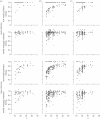Effects of weather and climate on the dynamics of animal population time series
- PMID: 20880886
- PMCID: PMC3049023
- DOI: 10.1098/rspb.2010.1333
Effects of weather and climate on the dynamics of animal population time series
Abstract
Weather is one of the most basic factors impacting animal populations, but the typical strength of such impacts on population dynamics is unknown. We incorporate weather and climate index data into analysis of 492 time series of mammals, birds and insects from the global population dynamics database. A conundrum is that a multitude of weather data may a priori be considered potentially important and hence present a risk of statistical over-fitting. We find that model selection or averaging alone could spuriously indicate that weather provides strong improvements to short-term population prediction accuracy. However, a block randomization test reveals that most improvements result from over-fitting. Weather and climate variables do, in general, improve predictions, but improvements were barely detectable despite the large number of datasets considered. Climate indices such as North Atlantic Oscillation are not better predictors of population change than local weather variables. Insect time series are typically less predictable than bird or mammal time series, although all taxonomic classes display low predictability. Our results are in line with the view that population dynamics is often too complex to allow resolving mechanisms from time series, but we argue that time series analysis can still be useful for estimating net environmental effects.
Figures

 , and the variance estimate of the one of the two models without covariates with the lowest AICc value,
, and the variance estimate of the one of the two models without covariates with the lowest AICc value,  , plotted against time-series length, n. For the first and third rows, the
, plotted against time-series length, n. For the first and third rows, the  are best-model estimates, and for the second and fourth rows they are model-averaged estimates. The two upper rows show estimates under the small collection of covariates and the two lower rows show estimates under the large collection. (a) Mammal datasets, (b) birds and (c) insects. Datasets for which the reduction in variance was significant at the 95 per cent level according to the resample test are marked with a cross.
are best-model estimates, and for the second and fourth rows they are model-averaged estimates. The two upper rows show estimates under the small collection of covariates and the two lower rows show estimates under the large collection. (a) Mammal datasets, (b) birds and (c) insects. Datasets for which the reduction in variance was significant at the 95 per cent level according to the resample test are marked with a cross.
References
-
- Andrewartha H. G., Birch L. C. 1954. The distribution and abundance of animals. Chicago, IL: University of Chicago Press
-
- Nicholson A. J. 1933. Supplement: the balance of animal populations. J. Anim. Ecol. 2, 131–178
-
- Bjørnstad O. N., Grenfell B. T. 2001. Noisy clockwork: time series analysis of population fluctuations in animals. Science 293, 638–64310.1126/science.1062226 (doi:10.1126/science.1062226) - DOI - DOI - PubMed
-
- Coulson T., Catchpole E. A., Albon S. D., Morgan B. J. T., Pemberton J. M., Clutton-Brock T. H., Crawley M. J., Grenfell B. T. 2001. Age, sex, density, winter weather, and population crashes in Soay sheep. Science 292, 1528–153110.1126/science.292.5521.1528 (doi:10.1126/science.292.5521.1528) - DOI - DOI - PubMed
-
- Benton T. G., Plaistow S. J., Coulson T. N. 2006. Complex population dynamics and complex causation: devils, details and demography. Proc. R. Soc. B 273, 1173–118110.1098/rspb.2006.3495 (doi:10.1098/rspb.2006.3495) - DOI - DOI - PMC - PubMed
Publication types
MeSH terms
LinkOut - more resources
Full Text Sources
Other Literature Sources

